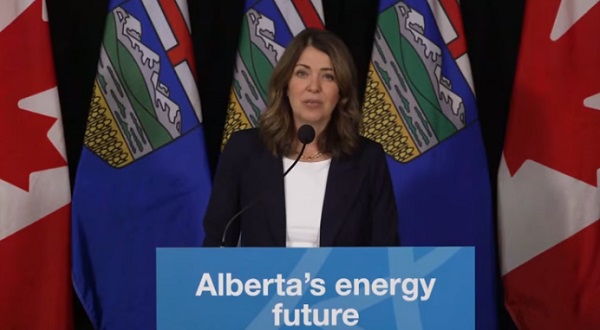Business
America’s Largest And Most Expensive DEI Program Is About To Go Up In Flames

The flag of the University of Michigan
 From the Daily Caller News Foundation
From the Daily Caller News Foundation
By Jaryn Crouson
The University of Michigan’s (UM) multi-million dollar diversity, equity and inclusion (DEI) program may soon be dismantled.
The university’s board of regents has reportedly asked UM president Santa Ono “to defund or restructure” the DEI office amid growing criticism and public pressure, according to emails shared on X. The board is expected to vote on the matter on Dec. 5.
“I write to share information with you about impending threats to the University of Michigan’s DEI programming and core values of diversity, equity, and inclusion,” Rebekah Modrak, faculty senate chair, wrote in an email to faculty senate members. “It has been confirmed by multiple sources that the Regents met earlier this month in a private meeting with a small subgroup of central leadership members, and among the topics discussed was the future of DEI at UM, including the possibility of defunding DEI in the next fiscal year.”
Calls for the university’s DEI program to come to a close surfaced after The New York Times exposed its failures and the vast amount of money being thrown at it.
“In recent years, as D.E.I. programs came under withering attack, Michigan has only doubled down on D.E.I., holding itself out as a model for other schools,” the NYT wrote in an October article. “By one estimate, the university has built the largest D.E.I. bureaucracy of any big public university. But an examination by The Times found that Michigan’s expansive — and expensive — D.E.I. program has struggled to achieve its central goals even as it set off a cascade of unintended consequences.”
Despite UM investing $250 million into DEI since 2016, students and faculty have reported a deteriorating campus climate since the program began and are less likely to interact with people of a different race, religion or political ideology, though these are “the exact kind of engagement[s] D.E.I. programs, in theory, are meant to foster,” the article stated. Attempts to create a more diverse campus also fell flat, with black enrollment at the university remaining a steady 5%.
The program also created a “culture of grievance,” with the office’s conception coinciding with an “explosion” of complaints on campus involving race, gender and religion, the NYT reported. Meanwhile, nearly 250 university employees were engaged in some form of DEI efforts on campus.
Modrak in her email referenced the article, calling it a “tendentious attack” that was “not well researched,” and claiming that the author “cherry-picked” examples of UM’s failures.
DEI staff cost the university approximately $30.68 million annually, with the average salary reaching $96,400, according to Mark Perry, an American Enterprise Institute scholar. Several DEI employees are paid more than $200,000 a year, while the department’s head makes upwards of $400,000.
“I think that across the ideological spectrum both regular citizens and policymakers have really shifted on issues of identity politics,” John Sailer, senior fellow and director of higher education policy at the Manhattan Institute, told the Daily Caller News Foundation. “I think a lot of people who would have at some point, probably just as a matter of knee-jerk reaction, supported diversity initiatives, have started to really reconsider what these initiatives are actually doing, and reconsider whether everything that falls under the name of DEI is actually something that they support. And so there was already the slow burn.”
The major catalyst of this change, Sailer explained, was the series of fiery protests that ravaged college campuses across the country after Hamas’ deadly Oct. 7, 2023 attack on Israel, which were “absolutely a big part of the story.”
“A lot of people were already skeptical of DEI,” Sailer said. “A lot of people were already of the opinion that these policies, even though they purport to be about diversity, in practice really have been about a particular ideological vision for higher ed. Then on October 7, I think a whole different part of the American electorate and a whole different constituency, many more people from the professional world looked at universities and thought, What on earth is going on? What is the problem here?”
The University of Michigan, like many other schools, was overwhelmed by violent protests that resulted in several arrests and criminal charges being filed against 11 students and alumni.
“It became clear that a part of the problem was we have these massive bureaucracies that should ostensibly promote treating people well,” Sailer continued. “And it was in fact a lot of people most involved with the DEI complex who were supporting these kind of radically anti-Israel, radically anti-West, at times, rudely antisemitic demonstrations.”
The reelection of former president Donald Trump on Nov. 5 likely played no small role in this shift either.
“I think now every elected official is aware that there’s something of a popular mandate to reform higher education, and that mandate existed before Trump was elected in 2024, but there’s also a kind of popular rebuke of the progressive identity politics,” Sailer said. “I have to think that the conversation that the University of Michigan’s regents are having about DEI would be different if there had not been this nationwide rebuke of identity politics that the election of Trump seems to represent.”
Trump has promised many reforms to the education sector, including abolishing the Department of Education entirely. The president-elect has also vowed to bring peace to Israel and Gaza and said that such efforts would help curb the rise in antisemitism in the U.S.
While several other schools have begun to dismantle DEI offices across the country, some in response to state laws barring the departments and policies, the case at the University of Michigan is unique. Most efforts thus far have been led by Republican lawmakers, such as in Texas and Florida, but in the blue state of Michigan, the university’s highest governing body is comprised almost entirely of Democrats.
“The fact that University of Michigan is an institution controlled by elected Democrats, the fact that its Board of Regents would consider doing something like this, I think it signals a broader shift,” Sailer said. “It’s a huge deal for the University of Michigan to even have this kind of reform on the table. It’s a huge deal because the University of Michigan is the exemplar when it comes to DEI. If the University of Michigan makes this decision, that marks a big shift.”
This move by the university could signal others to follow suit.
“It could be just a massive step towards broader higher education reform,” Sailer told the DCNF.
UM and the Board of Regents did not immediately respond to the DCNF’s request for comment.
Alberta
Falling resource revenue fuels Alberta government’s red ink

From the Fraser Institute
By Tegan Hill
According to this week’s fiscal update, amid falling oil prices, the Alberta government will run a projected $6.4 billion budget deficit in 2025/26—higher than the $5.2 billion deficit projected earlier this year and a massive swing from the $8.3 billion surplus recorded in 2024/25.
Overall, that’s a $14.8 billion deterioration in Alberta’s budgetary balance year over year. Resource revenue, including oil and gas royalties, comprises 44.5 per cent of that decline, falling by a projected $6.6 billion.
Albertans shouldn’t be surprised—the good times never last forever. It’s all part of the boom-and-bust cycle where the Alberta government enjoys budget surpluses when resource revenue is high, but inevitably falls back into deficits when resource revenue declines. Indeed, if resource revenue was at the same level as last year, Alberta’s budget would be balanced.
Instead, the Alberta government will return to a period of debt accumulation with projected net debt (total debt minus financial assets) reaching $42.0 billion this fiscal year. That comes with real costs for Albertans in the form of high debt interest payments ($3.0 billion) and potentially higher taxes in the future. That’s why Albertans need a new path forward. The key? Saving during good times to prepare for the bad.
The Smith government has made some strides in this direction by saving a share of budget surpluses, recorded over the last few years, in the Heritage Fund (Alberta’s long-term savings fund). But long-term savings is different than a designated rainy-day account to deal with short-term volatility.
Here’s how it’d work. The provincial government should determine a stable amount of resource revenue to be included in the budget annually. Any resource revenue above that amount would be automatically deposited in the rainy-day account to be withdrawn to support the budget (i.e. maintain that stable amount) in years when resource revenue falls below that set amount.
It wouldn’t be Alberta’s first rainy-day account. Back in 2003, the province established the Alberta Sustainability Fund (ASF), which was intended to operate this way. Unfortunately, it was based in statutory law, which meant the Alberta government could unilaterally change the rules governing the fund. Consequently, by 2007 nearly all resource revenue was used for annual spending. The rainy-day account was eventually drained and eliminated entirely in 2013. This time, the government should make the fund’s rules constitutional, which would make them much more difficult to change or ignore in the future.
According to this week’s fiscal update, the Alberta government’s resource revenue rollercoaster has turned from boom to bust. A rainy-day account would improve predictability and stability in the future by mitigating the impact of volatile resource revenue on the budget.
Business
Higher carbon taxes in pipeline MOU are a bad deal for taxpayers

The Canadian Taxpayers Federation is criticizing the Memorandum of Understanding between the federal and Alberta governments for including higher carbon taxes.
“Hidden carbon taxes will make it harder for Canadian businesses to compete and will push Canadian entrepreneurs to shift production south of the border,” said Franco Terrazzano, CTF Federal Director. “Politicians should not be forcing carbon taxes on Canadians with the hope that maybe one day we will get a major project built.
“Politicians should be scrapping all carbon taxes.”
The federal and Alberta governments released a memorandum of understanding. It includes an agreement that the industrial carbon tax “will ramp up to a minimum effective credit price of $130/tonne.”
“It means more than a six times increase in the industrial price on carbon,” Prime Minister Mark Carney said while speaking to the press today.
Carney previously said that by “changing the carbon tax … We are making the large companies pay for everybody.”
A Leger poll shows 70 per cent of Canadians believe businesses pass most or some of the cost of the industrial carbon tax on to consumers. Meanwhile, just nine per cent believe businesses pay most of the cost.
“It doesn’t matter what politicians label their carbon taxes, all carbon taxes make life more expensive and don’t work,” Terrazzano said. “Carbon taxes on refineries make gas more expensive, carbon taxes on utilities make home heating more expensive and carbon taxes on fertilizer plants increase costs for farmers and that makes groceries more expensive.
“The hidden carbon tax on business is the worst of all worlds: Higher prices and fewer Canadian jobs.”
-

 Alberta6 hours ago
Alberta6 hours agoFrom Underdog to Top Broodmare
-

 Artificial Intelligence2 days ago
Artificial Intelligence2 days agoTrump’s New AI Focused ‘Manhattan Project’ Adds Pressure To Grid
-

 International1 day ago
International1 day agoAfghan Ex–CIA Partner Accused in D.C. National Guard Ambush
-

 Alberta1 day ago
Alberta1 day agoAlberta and Ottawa ink landmark energy agreement
-

 International2 days ago
International2 days agoTrump orders 500 more troops to reinforce D.C. after Guard shooting
-

 armed forces2 days ago
armed forces2 days agoCarney’s ‘Shared Sacrifice’ Is a Lie. Only Veterans Are Bleeding for This Budget
-

 Energy1 day ago
Energy1 day agoPoilievre says West Coast Pipeline MOU is no guarantee
-

 International2 days ago
International2 days agoTrump Admin Pulls Plug On Afghan Immigration Following National Guard Shooting










